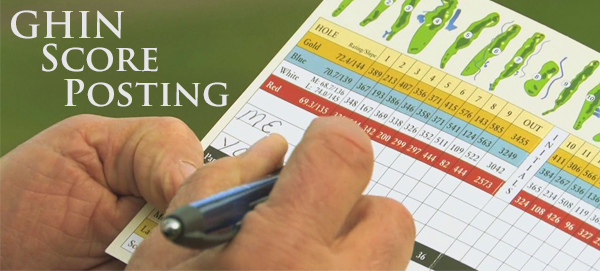Two basic premises underlie the USGA Handicap System, namely that each player will try to make the best score at every hole in every round, regardless of where the round is played, and that the player will post every acceptable round for peer review. The player and the player's Handicap Committee have joint responsibility for adhering to these premises.
Posting scores in person immediately following the round at the course where the round is played is the preferred way to expose scores to peer review. If a player fails to post a score, the Handicap Committee may post the score without the player's authorization. After a competition, the Committee in charge of the competition may post the scores of all competitors. The Committee must notify the players that it will post the scores in order to prevent scores from being posted by both the players and the Committee.
It is advisable to send a notice to members before the season starts in order to outline the USGA Handicap System, to stress the importance of reporting all acceptable scores and to report the Handicap Committee's policies.
If a player fails to post an acceptable score as soon as practical after completion of the round, the Handicap Committee has three options:
1) Post the actual score made by the player;
2) Post a penalty scoreequal to the lowest/highest Handicap Differential in the player's scoring record;
3) Post the actual score and a penalty score
The Handicap Committee is not required to notify the player prior to posting a penalty score.
The Handicap Committee has the responsibility of making certain that each player has a Handicap Index reflecting potential ability. Under the following circumstances, it will be necessary for the Handicap Committee to adjust the player's Handicap Index. However, the following list is not all-inclusive, and a Handicap Committee has the ultimate authority to adjust a Handicap Index under any circumstance that it feels necessary to do so. Before an adjustment becomes effective, the Handicap Committee must give the player an opportunity to explain the circumstances surrounding the proposed adjustment, either in writing or by appearing before the Committee. When an adjustment does become effective, it must be identified with the letter M, indicating that the Handicap Committee has modified the Handicap Index (e.g., 4.9M).
Relevant Sections of the USGA Handicap Manual
(iv) Player Manipulates Round
The Handicap Committee must adjust or withdraw the Handicap Index of a player who manipulates scores. (See Section 8-4f.) Examples of manipulating scores include the following:
(a) Posting erroneous information to the scoring record;
(b) Stopping play prior to 7 holes to avoid posting scores;
(c) Repeatedly playing more than one ball to avoid posting scores; (See Decision 5-1a/5);
(d) Not adjusting hole scores under Section 4;
(e) Deliberately reporting more or fewer strokes than actually taken;
(f) Deliberately taking extra strokes to inflate a score.
(g) Not observing either or both of the two basic premises that underlie the USGA Handicap System(see Section 1-1)
(v) Continued violations of Section 5-1e.
The Handicap Committee is responsible for identifying and notifying a player who regularly violates any provision within Section 5-1e that such rounds are unacceptable for handicap purposes. If the player persists in violating clause(s) within Section 5-1e after being notified by the Handicap Committee, the Handicap Committee is authorized and encouraged to consider withdrawal of the player's Handicap Index.
The Handicap Committee must determine how long a player's Handicap Index is to remain modified or withdrawn. At each handicap revision date, the Handicap Committee should compare the modified Handicap Index to the value determined by the normal computation method under Section 10-2. For example, the Handicap Committee may lift a modified Handicap Index of 4.9M, when subsequent scores posted to a player's scoring record produce a lower Handicap Index (e.g., 4.0).
The Handicap Committee must withdraw the Handicap Index of a player who repeatedly fails to meet the player responsibilities under the USGA Handicap System. Before any action is taken, the player must be advised of the information available to the Handicap Committee and be invited to respond to the Handicap Committee either in writing or by appearing in person. A withdrawn Handicap Index may be reinstated under conditions set forth by the Handicap Committee. (See Decision 5-2a/4.)
Sample Letter: Modified Index
[Club Stationery]
[Date]
Dear
After reviewing your scoring record, the Handicap Committee of [club name] has determined that your Handicap Index® does not accurately reflect your potential playing ability. We have concluded that [your rapid improvement, your numerous away scores, your recent injury, your failure to post scores, your posting of erroneous scores] has produced a Handicap Index that is not accurate.
In the interest of fair play, the Handicap Committee is going to modify your Handicap Index under Section 8-4c of "The USGA Handicap System." Your Handicap Index will become [e.g., 7.6M]. Before the adjustment becomes effective, you may appeal to the Handicap Committee either by letter or in person by [date]. If the Handicap Committee does not hear from you or determines that the reasons for modification are still valid, the modified Handicap Index will become effective on [date].
The Handicap Committee will review this adjustment at each handicap revision date to determine if your Handicap Index should revert to the normal handicap formula computation by Section 10-2. In the meantime, continue to post all of your scores and observe all aspects of the USGA Handicap System.™
Sincerely,
Handicap Chairperson
